The pandemic changed the retail business landscape once and for all. While many businesses were bracing for the worst and struggling to keep up with changing trends in eCommerce, brands that adopted an app-based strategy and rode the famous and circumstance-driven app adoption wave emerged successfully.
Are you still considering getting a native mobile app for your Shopify store?
Why does your brand need a native mobile app? Let the Shein and Nike success stories answer that question –
Nike’s digital revenue skyrocketed by a staggering 84% in the third quarter – all thanks to its app-based, direct-to-consumer strategy, which garnered record-breaking engagement.
Its group of apps – Nike, Nike Run Club, and SNKRS crafted niche, meticulously designed user experiences that boosted loyalty, reinforced brand image, made it more accessible, and helped the brand have a record-breaking year of sales.
This success can be attributed to how Nike took charge of its growth and pandemic response by building relationship-cementing experiences through apps.
Nike has aced customer retention with a delightful ‘store-in-pocket’ experience, successfully leveraged consumer data from its suite of apps, and fashioned it into a feedback loop for its retail outlets.
And although many viewed this as pandemic-prompted innovation, progressive brands that were attuned to their customers’ needs had already jumped on the app-commerce bandwagon in the latter part of the last decade. Fast fashion brand Shein is an excellent example of this.
The fastest-growing e-commerce company in the world, Shein has grown by over 100% over the past ten years. Do you know what powers the Shein engine? The Shein app; 72% of its customers come from the app.
The brand has successfully managed to cut down on customer acquisition and retention costs significantly with first-timer discounts, gamified in-app experiences, push notifications and live streaming ‘shoptainment’ events that encourage repeat usage and build addiction. Shein has pioneered a discovery-driven recommendation feed heavily dependent on the massive amount of first-party data it generates from its app. What makes Shein the market leader is this customer-focused app-commerce strategy.
Customer trends were already signaling a gradual but definite shift in consumer preferences, as indicated by the numbers –
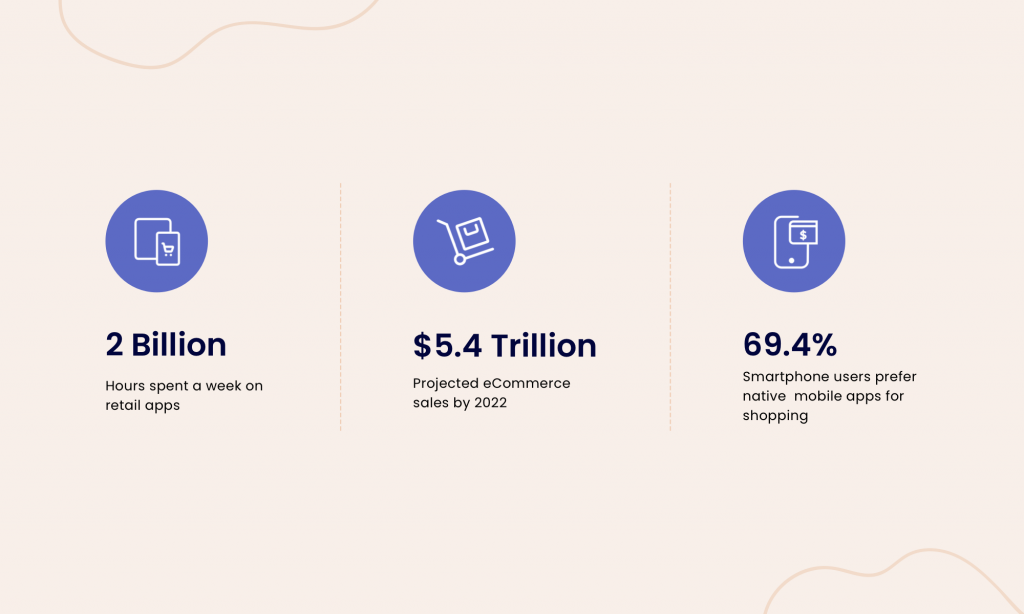
Mobile app use was thought to die down after 2020, but apps are still being used as substitutes for previous in-person behaviors, despite the initial global reopening of stores. As a retail brand owner, a direct-to-consumer, owned channel strategy with a native mobile app is key to surviving and thriving. Explore why apps trump other popular sales channels and why you need an app.
Seven reasons why your brand needs a mobile app
It is where your largest customer group is – on apps.
You have a mobile responsive website. Good job; that’s necessary but not enough. There are two compelling reasons why a mobile responsive website is not enough – one, mobile apps convert up to 10x higher than mobile web, and two, the modern customer expects you to provide a seamless & frictionless shopping experience with an app and thinks little of brands who don’t have an app.
Shopify reports indicate that by the third quarter of 2019, 81% of traffic was coming from mobile devices. But a common issue most Shopify merchants face is that this traffic does not translate to conversions and sales. This is because a mobile website-based buyer journey has too many cracks that purchases can slip through.
For starters, it’s the load time. On a fundamental level, apps are native and hence faster than the mobile web – data transmission is as much as 10x lesser between a server and a mobile app than between a server and a browser, so native apps fetch data much faster than websites. Popular statistics conclude that roughly one out of two website visitors go to a competitor after a bad mobile experience.
Your customer base doesn’t have time to spend on mediocre browsing and surfing experiences. Imagine this – Steve’s forgotten his wedding anniversary. He panics. He wants to buy his wife a dress – stat. He remembers that his wife loves your brand. He hurriedly goes to your website. But your website takes too long; Steve gets annoyed and goes to your competitor. Bummer! Every second your Shopify page spends loading, you experience a 7% conversion loss. Moreover, apps offer more mobility and convenience and allow customers to pick up where they left off. Shoppers that use mobile apps browse 286% more products and spend 18x more time in the app.
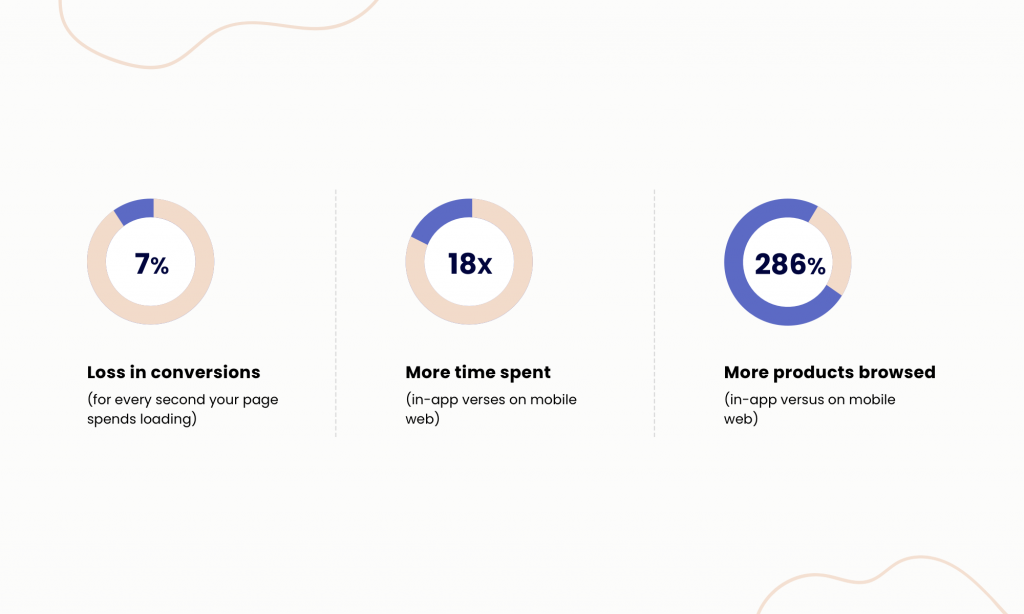
Apps make for better shopping experiences by enabling customers to take advantage of phone-native features such as GPS-based personalization, AR (Augmented Reality) & VR (Virtual Reality), and live streaming.
As for reason #2, why mobile-responsive sites are not enough, data speaks volumes. Users have spent 49% more on these apps since January 2020, reaching nearly 18 million weekly hours in April 2021. Google’s recent market research titled “Retail Apps: Accelerated Adoption” explores why apps are crucial to modern business and driving commercial and non-commercial KPIs. The paper analyzes post-pandemic app adoption trends through a behavioral science lens and features customer excerpts.
One of the respondents says, “In the past, I would go check out malls and see the stores. Now I bring them to me. Shopping on apps has become more normal. It’s not just the pandemic. The apps are better and better.”
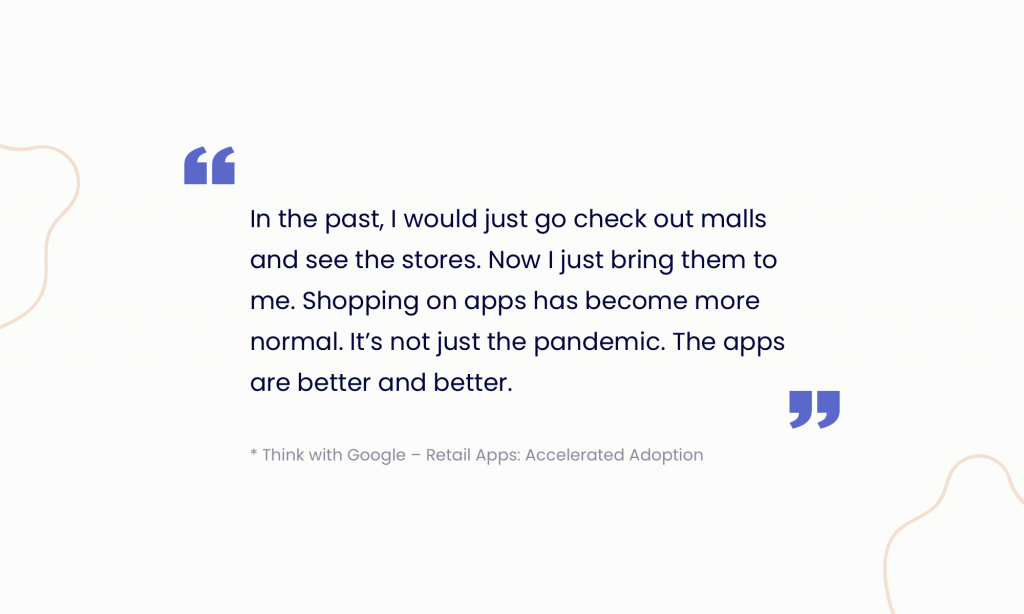
Customers want to shop with brands whose brand image and values they can align to. Another respondent from the same survey remarks, “If they (brands) don’t have a modern app, I think: get with the times. You’re a mammoth and going to go extinct. I want to shop with forward-thinking companies that will be around in the future.”
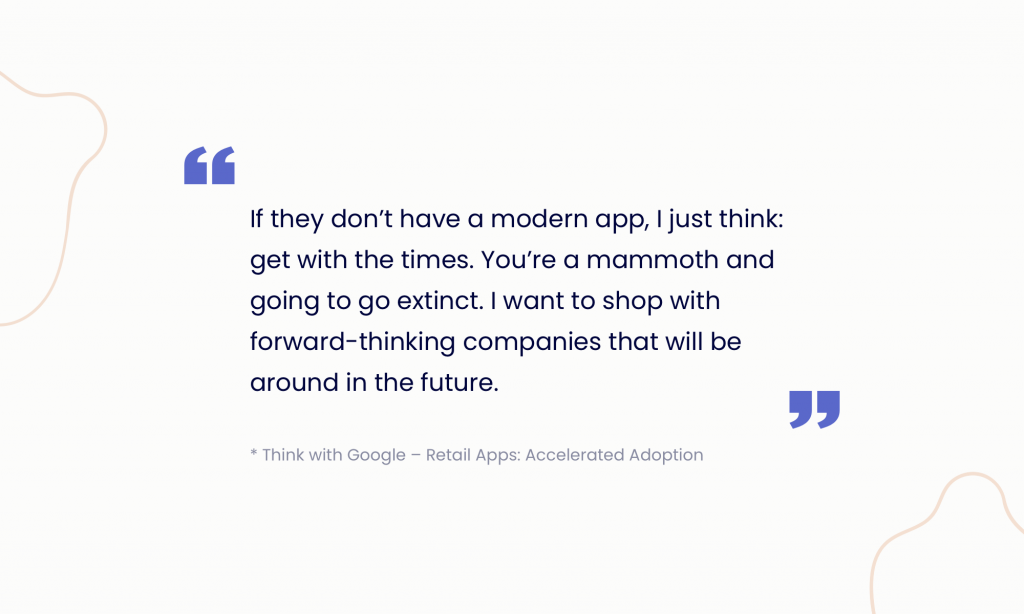
An app-based shopping experience is more personal, driven by the convenience of format and the sense of touch. It is a relaxing experience, something most modern customers crave when they lay in bed after a long day or are looking for ways to entertain themselves as they wait in the doctor’s office, for instance. They can snuggle up on the couch with their favorite brands and the products that interest them just inches away from their nose.
Scrolling and tapping have a tactile feel; this is as close as it gets to shopping in their favorite mall. The only difference is that shopping on a mobile app with push notifications guarantees more engagement and repeat purchases – an app saves your customers’ preferences and buying history. The more data you acquire about your customers’ interests and buying intent, the higher the likelihood of purchases and higher AOVs. In-person shopping does not facilitate these as quickly.
It is no more missing out on conversions at checkout.
Let’s revisit Steve. He has found something he likes on your website. He adds it to the cart and heads over to check out. But, he gets lost in your checkout flow which can only generously be called “complex.” If checkout is not straightforward, quick, and painless, you’ll lose out on conversions from loyal customers like Steve.
Most Shopify store owners struggle with staggeringly high rates of abandoned carts. According to the Baymard Institute, which studies usability issues, the average cart abandonment rate is 69.8%. $260 billion can be recovered from orders that are abandoned at check out, with checkout flow optimization that apps offer.
Take Amazon’s example – One-Click Checkout for Amazon Prime members has streamlined the checkout process significantly. You, too, can add native payment options like Apple Pay to your brand’s app and recreate this seamless checkout experience. Apple Pay securely pre-fills your account information, your credit card information, and shipping/billing addresses, so your customers can complete payment and make a purchase with one tap.
More than 50% of customers will abandon shopping entirely if a web page takes longer than three seconds to load. So, a slow checkout will most certainly annoy your customers and result in cart abandonment. But, within apps, you can have one-click checkouts that take only about 5 – 8 seconds to complete.
For the customers that still abandon carts, you can send abandoned cart push notifications and remind them about their carts.
Abandoned cart push notifications convert 300% higher than abandoned cart email and SMS. Not only abandoned carts, but with a native app, you get insights that enable you to run push notification campaigns for abandoned browsing and wishlists.
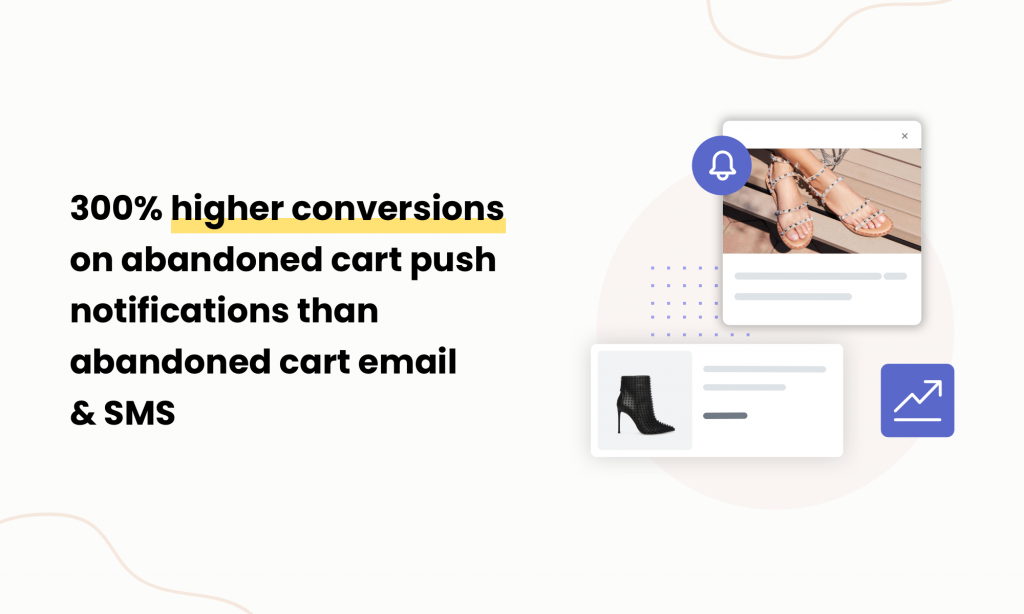
Sell what your customers want to buy when they’re most likely to buy
Native apps can send push notifications that allow you to advertise and reach out to your customers at just the right time – when purchase intent is high. You can send super-relevant push notifications based on user behavior and app performance, geographical location, purchase history, and more.
You can also offer incentives, such as in-app discounts, exclusive product launches, time-based reminders, or member-only sales that dramatically increase the chances of purchases. App engagement rates are 88% higher with such push notifications.
Push notifications have an incredibly high deliverability rate of 90%, a 50% higher open rate, and a whopping 7x greater click rate than email. Shopping reminders and notifications sent via SMS and email will likely end up in the spam or be ignored. Text-based reminders are not as effective as well-timed, dynamically generated rich push notifications sent to a segmented audience.
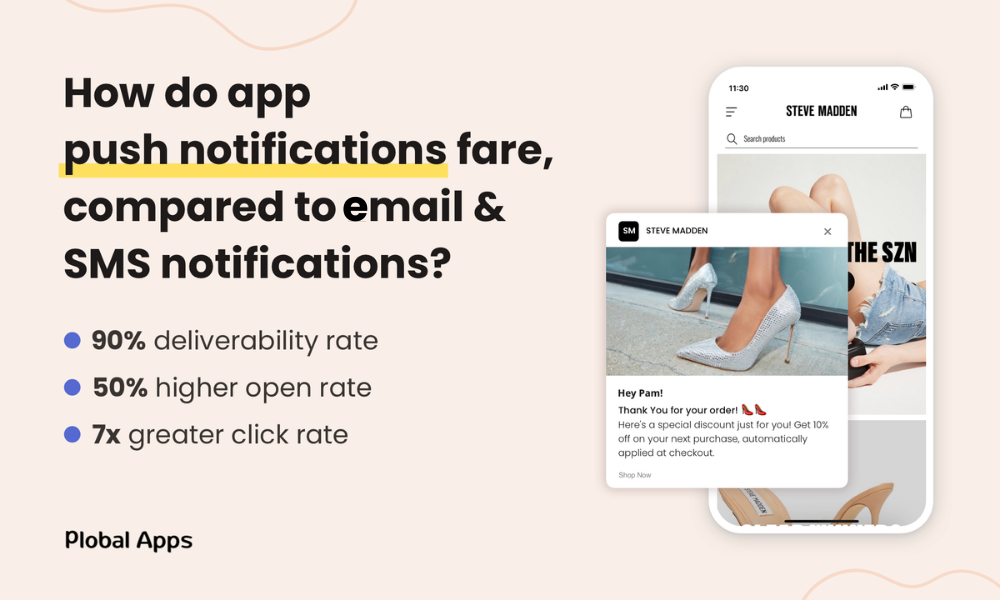
Plus, there are costs associated with sending SMS notifications. Your reach is limited, too – some regions have strict rules concerning SMS. Push notifications with popular app builders are free.
App-based push notifications deliver a much higher ROI and don’t ask much from your users. Your customers don’t have to open them unless they want to open the app – they can just be viewed from the notifications tab on their mobile devices.
There’s no extra cost associated with bulk as there is for email or SMS. You can send highly effective, segmented push notifications for free, whether you send a thousand or a hundred thousand of them.
Make shopping with your brand a habit for your customers
Acquiring a new customer can cost five times more than retaining an existing customer. Increasing customer retention by just 5% can increase profits up to as much as 95%.
While SMS and email play a part in keeping your customers coming back for purchases, they’re not as effective for customer retention as apps; their performance has either declined or plateaued over the years.
A native app empowers you to personalize your communication to an impressive degree. Personalized push notifications help you build segmented journeys for different audiences based on customer behavior. These go a long way in customer retention.
The better, more personalized the shopping experience, the higher the number of lucrative repeat purchases.
A testament to the effectiveness of retention-oriented shopping experiences that apps provide is that within just six months, merchants for whom we designed app success journeys saw roughly 30% of total revenue contribution through their app.
A customer’s high LTV or lifetime value is what brands vie for, and personalized notifications through an app are critical to this.
Get great ROI with one of the best-owned marketing channels
Business is built on relationships. And business is built on data. With a dedicated app for your online store, you kill nurture two birds with one stone – you enable your team to execute their vision of the customer journey that they have painstakingly curated and progressively refined. You also gain complete control of customer data.
This gives you better analytics and AI, more insights, and a way to perfect your messaging(via accurately timed push and in-app notifications that come as a welcome surprise rather than an annoying interruption and copy that perfectly preserves your unique brand identity). Such personalization improves the open rate by a whopping 800%.
An app is a remarkable opportunity to identify and embrace your brand personality. Take luxury apparel brand Balenciaga’s app, for example – it is an aesthetically pleasing manifestation of the brand’s personality and values of progressiveness, minimalism, modernism, and commitment to ethics and sustainability.
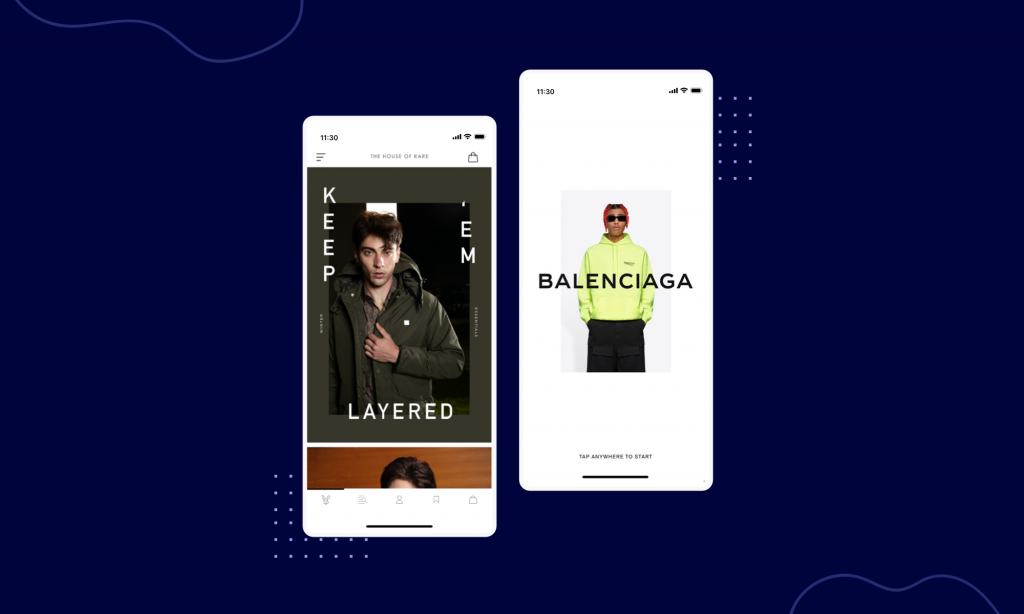
However, it is less about compact visual representation and messaging and more about the power of the mobile app. The Balenciaga app has also enabled the brand to take advantage of well-timed shopping reminders & flash opportunities, release exclusive products & collections, and provide loyalty-based discount opportunities which promote more installs, retain customers on the app, reinforce the brand image, and potentially garner earned media.
Get customer insights your Shopify store won’t give
A brand’s native app records data such as the buying history of the customer, the customer’s product preferences, when they open the app, for how long, how much time they spend on what screen of your app, and what regional or sociological factors influence their buying patterns.
Not only so, popular app builders include tools that accurately analyze this data, recognize patterns and trends, provide you with niche user behavior insights, and enable you to make data-backed decisions that result in more conversions, boosts in sales, and higher AOVs (Average Order Values)
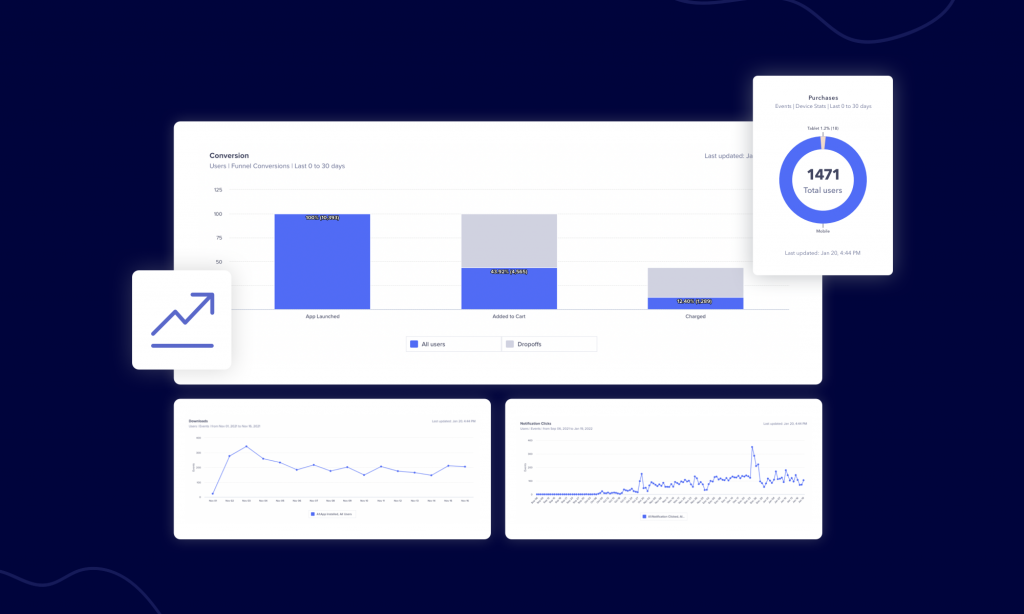
Make shopping easy and entertaining with live selling
The tremendous popularity of Tik Tok and short-form video content has had a telling effect on the retail sector. Industry bigwigs from apparel, beauty, and home goods are already killing it by reaching their customers on their phone screens, live.
Although live-streaming commerce is relatively new, it has already taken off. Apparel giant Tommy Hilfiger has had a massively successful live-streaming effort in China, where an audience of 14 million watched one show. The brand managed to sell 1,300 hoodies in just two minutes. In September 2020, the brand extended its live stream program to Europe and North America and showcased its Fall 2020 Tommy Hilfiger, Hilfiger Collection, and Tommy Jeans collections.
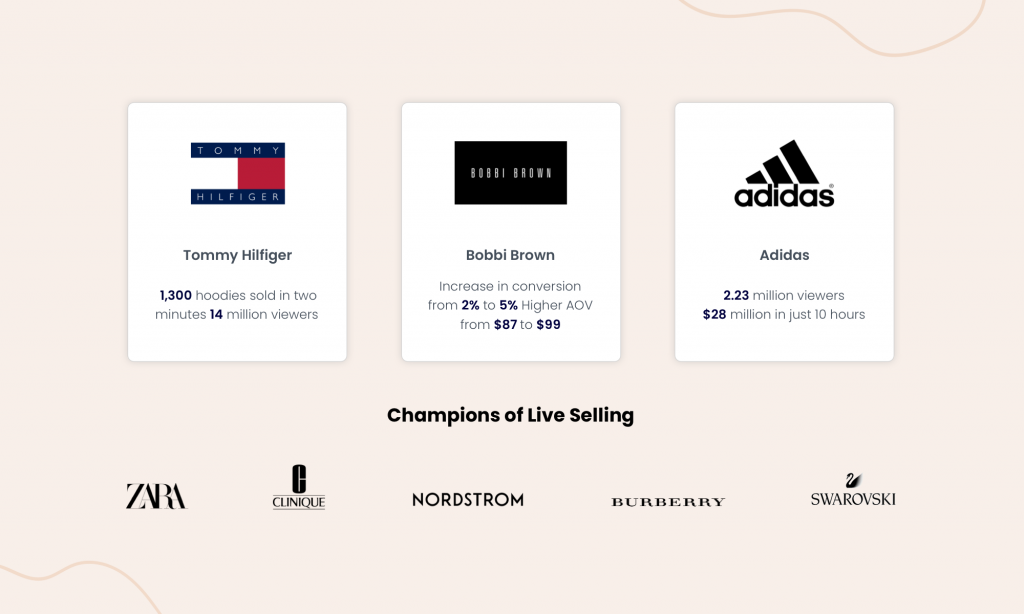
The beauty industry is at the forefront of “live stream commerce” with brands like Estée Lauder, Clinique, Urban Decay, Lancôme, NYX Cosmetics, and Kiehl’s who regularly host live streams where influencers generate content from the brand’s products such as skincare and makeup routines. At the same time, the audience can buy the products featured. Cosmetics and skincare company Bobbi Brown’s live streaming numbers are impressive too – its live streaming commerce conversion rate was 5%, the AOV was $99, up from the standard conversion rate of 2%, and the AOV of $87.
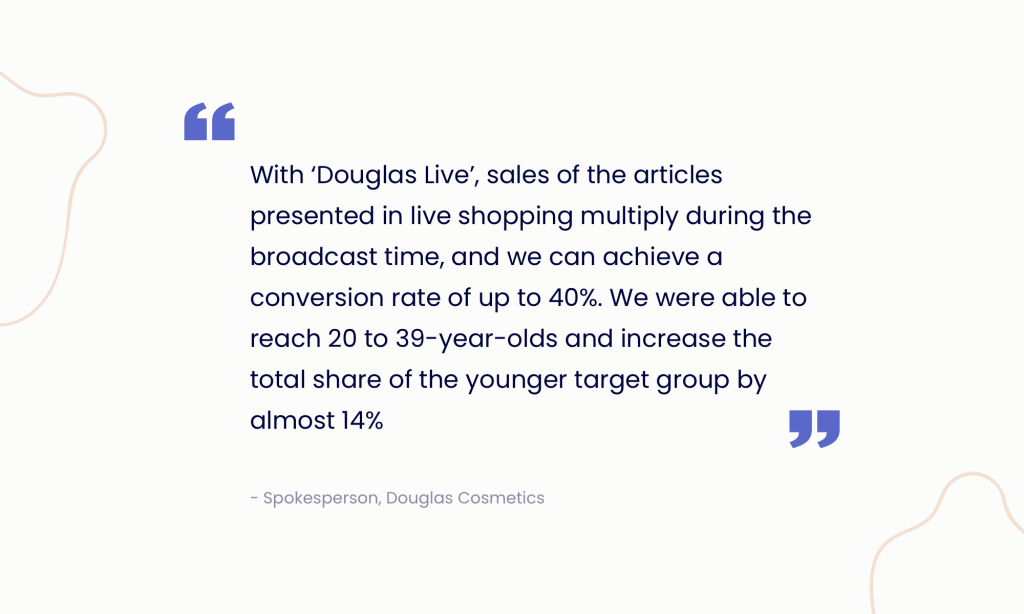
These numbers don’t seem far-fetched when you understand why it works; Shoppers belonging to Generation Z (Gen Z) are heavily influenced by social media, online content, and celebrities. As they start earning, their spending power will grow, and they will slowly overtake Millennials to become your largest customer group.
These buyers are impatient and accustomed to the convenience of the global digital marketplace, where they can find exactly what they’re looking for and deliver it to their doorstep in hours. So, attracting customers and keeping them engaged to increase AOVs and conversions is critical to thriving in the consumer economy. There has been a steady increase in disposable income, and as this consumer spending continues to grow, your customers will be able to buy what they see instantly. You can make that happen with live selling.
Live selling can be a great asset to your brand and contribute to a sizeable number of sales. The real-time engagement it fosters through highly interactive visual storytelling can be traced back to the ‘QVC’ or teleshopping era. A happy marriage of “catered & curated shopping with a shopping associate” and convenience, live-streaming, a renewed version of the classic shopping channel, creates a sense of urgency and gets you those coveted impulse buys from your customers.
Today’s live streams involve influencers showing products and encouraging instant purchases with giveaways, new product unboxing, raffles, special edition & limited-time items, and more. This “shoptainment” is a brilliant way of garnering valuable engagement that boosts retention and increases average session time in the app.
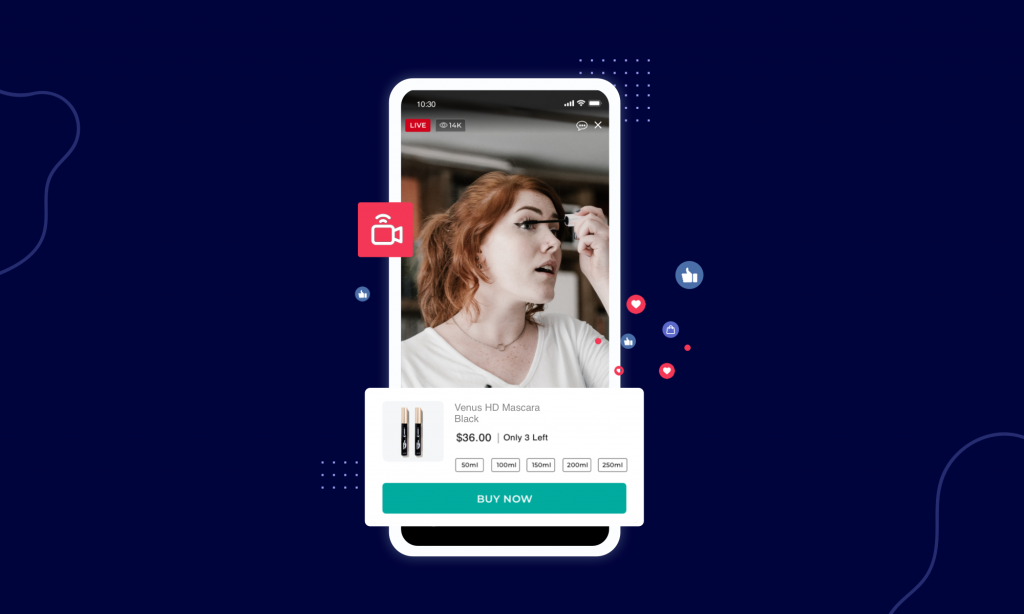
Further, there’s a host of actionable data you can track from live streams in your native app with real-time predictive analytics to profile & segment your customers better.
Getting your app is incredibly quick and easy if you choose the right app-commerce partner.
All aboard the app train!
Mobile commerce has shifted from mobile-responsive websites to an app-based strategy. Retailers are redesigning their eCommerce experience to reflect their audiences’ shopping preferences. Brands with successful brick-and-mortar stores like Steve Madden, Nike, and Zara leverage apps to engage with consumers better, build brand loyalty and form a multi-touchpoint commerce ecosystem anchored by native apps.

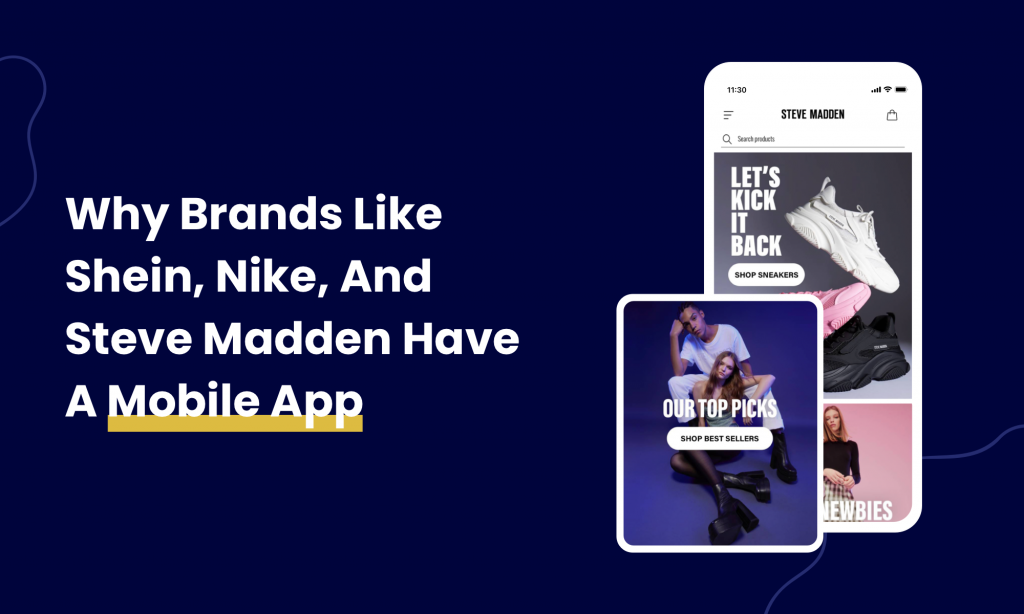


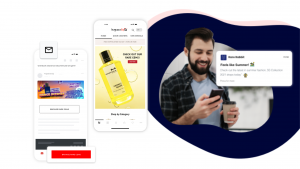
Share Your Views!